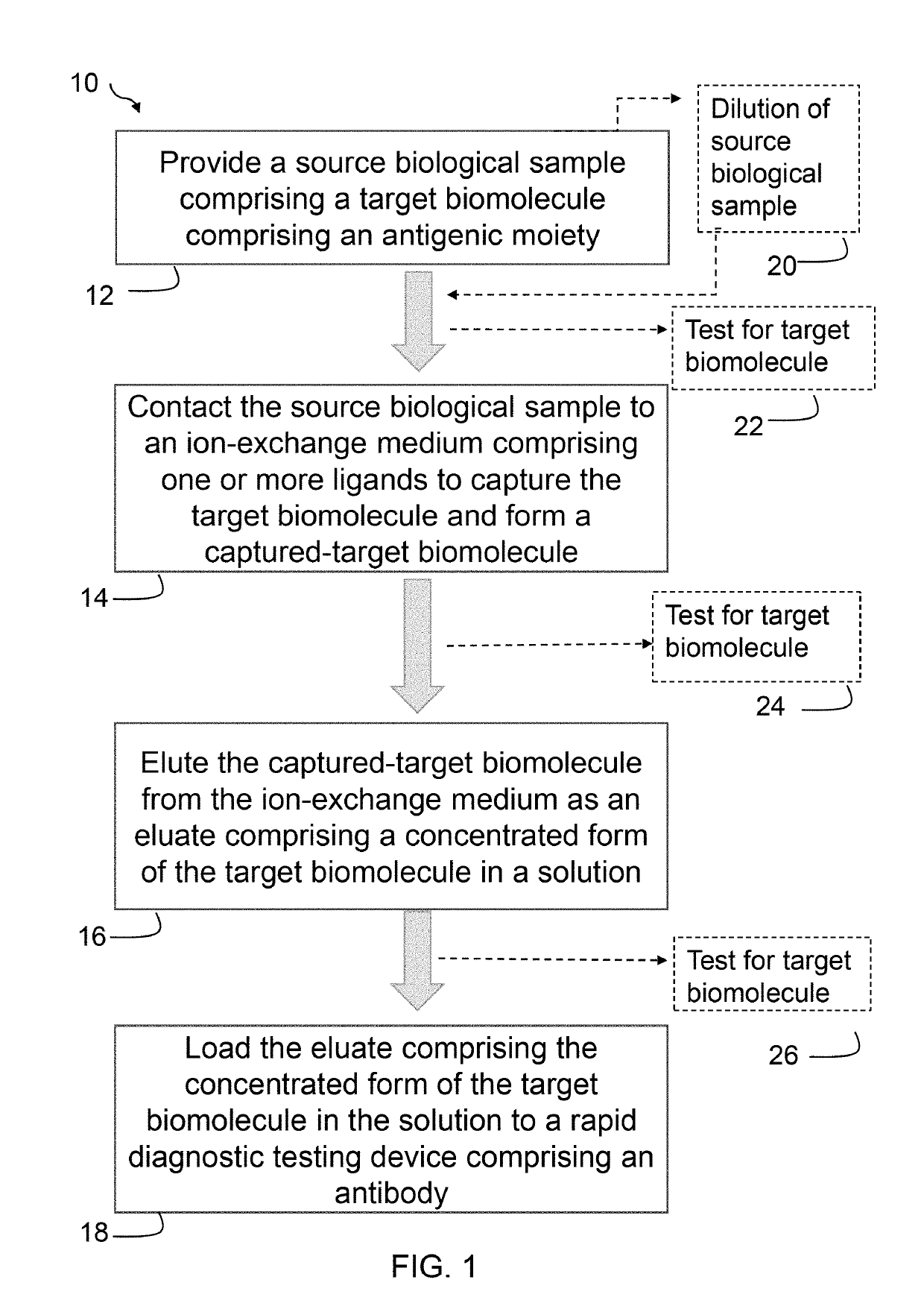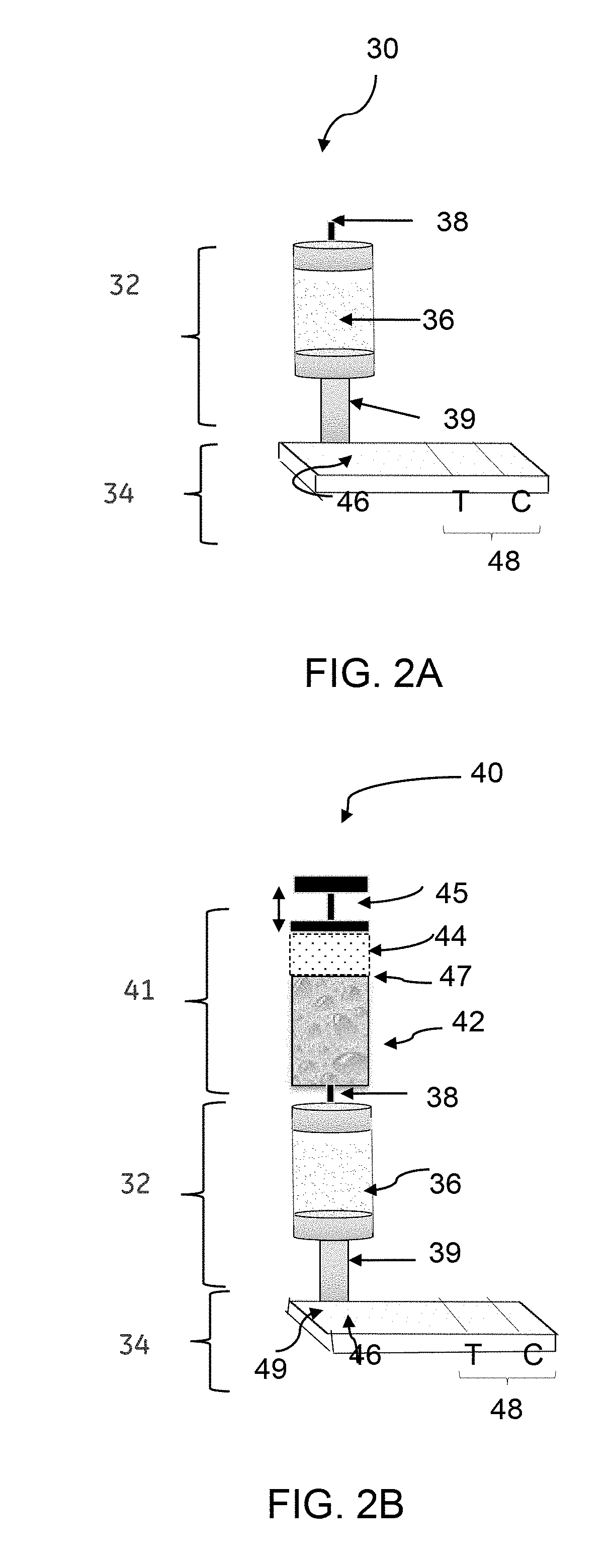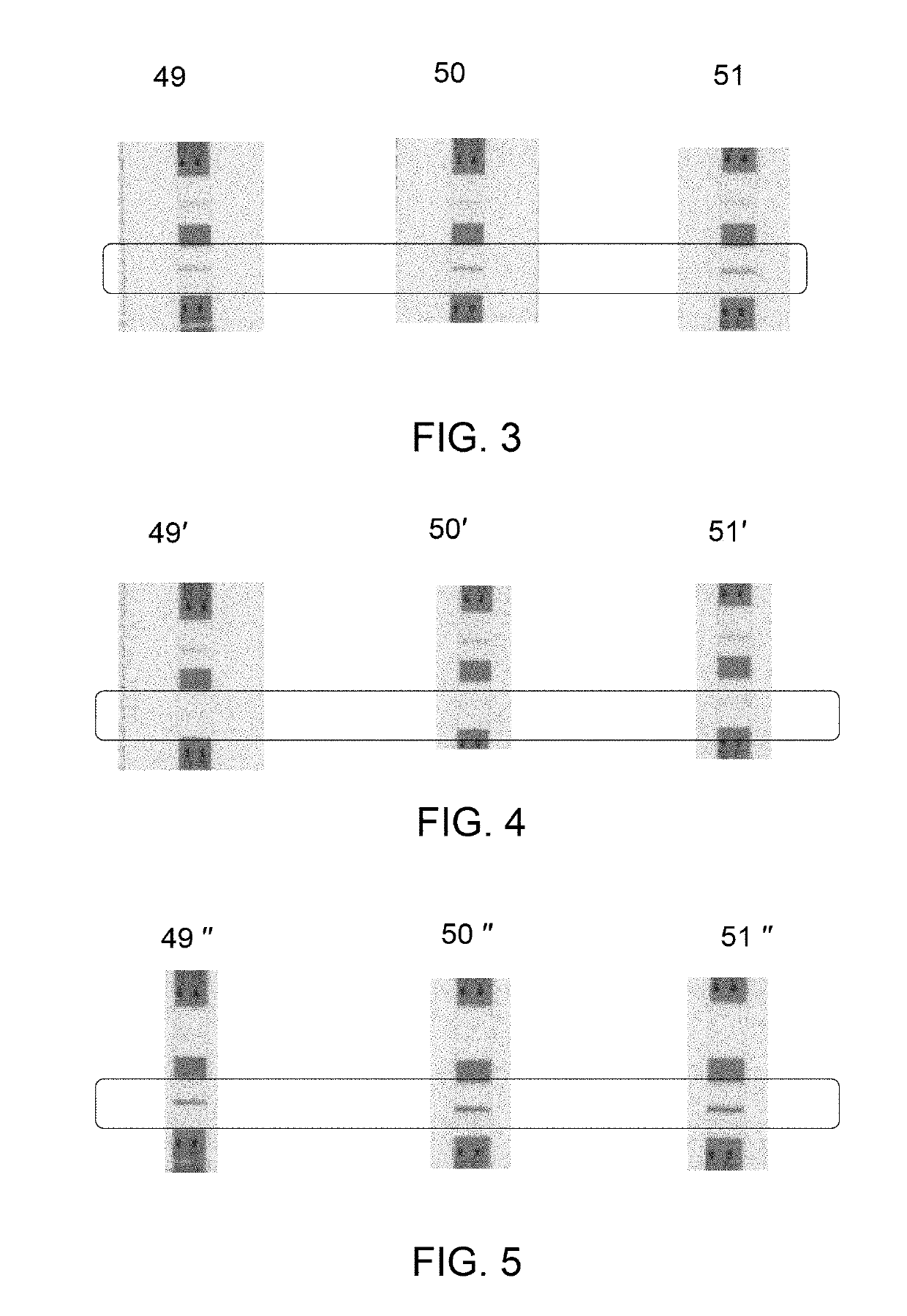Method and associated device for rapid detection of target biomolecules with enhanced sensitivity
a biomolecule and target technology, applied in the field of enhanced sensitivity target biomolecule detection methods and associated devices, can solve the problems of inefficient detection methods, lack of accurate rapid point-of-care diagnostic tests, different tuberculosis, etc., and achieve the effect of rapid diagnostic testing and rapid detection of a biomolecul
- Summary
- Abstract
- Description
- Claims
- Application Information
AI Technical Summary
Benefits of technology
Problems solved by technology
Method used
Image
Examples
example 1
Dilution of a Source Urine Sample in Concentrating TB-LAM Present in the Source Urine Sample Using an Ion Exchange Medium
[0061]A urine sample was spiked with TB-LAM to have a final concentration of 24 ng / ml for TB-LAM in the urine sample. The urine sample was diluted to 4× to reduce the conductivity to a range that is optimal for an anion exchange membrane to bind the TB-LAM antigen. 6.2 ml of the diluted urine sample containing 6 ng / ml TB-LAM was applied to a Q+ membrane column, wherein the TB-LAM was captured to the Q+ membrane column (i.e., membrane-bound TB-LAM or captured TB-LAM). The membrane-bound TB-LAM was eluted from the Q+ membrane column using 1.35 M NaCl in 20 mM Tris buffer. 0.1 mL eluate was loaded to an RDT device, wherein the eluate contained TB-LAM at a concentration of 315.1 ng / ml in an elution buffer containing 1.35 M NaCl in 20 mM Tris buffer. The TB-LAM was concentrated to 51.5-fold using the Q+ membrane column. The result yields about 13× increase in concentra...
example 2
ve Analysis of Urine Sample Containing TB-LAM Before and after Concentrating the Urine Sample
[0062]Preparation of Q+ Membrane Columns:
[0063]Predictor® ReadyToProcess Adsorber Q+96-well plate columns (or Q+ membrane columns) were prepared for binding of TB-LAM antigen from human urine samples by washing each well with 2 mL of acidified buffer solution. After washing the Q+ membrane column, the column was equilibrated with a neutral pH buffer solution (e.g., phosphate buffered saline (PBS)).
[0064]Preparation of Urine Sample Containing TB-LAM:
[0065]TB-LAM antigen was added to a urine sample to attain a TB-LAM concentration of 24 ng / mL. The urine sample was diluted (4× dilution) to generate a diluted urine sample having desired salinity and enable efficient binding to the anion exchange membrane (e.g., ˜10 mS / cm). The resulting concentration of TB-LAM antigen was 6 nanogram / mL (ng / mL), which is a level in the typical range for a human TB-infected patient and in the working range of comm...
example 3
ive Analysis of Urine Sample Containing TB-LAM Before and after Concentrating the Urine Sample
[0070]The source urine sample before applying to the column, and the eluate for different samples (N=2) were quantified by ELISA assay against a standard dilution series of TB-LAM in the solution used at each point of the assay. A quantitative estimation included determination of concentration of TB-LAM in the source urine sample and in eluate by standard ELISA bio-quantification methodology as described below. The eluate containing TB-LAM was directly applied to an ELISA reaction, wherein the eluate contained TB-LAM in an elution buffer of 1.35 M NaCl in 20 mM Tris.
[0071]Preparation of Reagents for ELISA:
[0072]Carbonate Coating Buffer was prepared by using contents of 1 capsule material into 100 mL double distilled water (ddH2O). Capture antibody (IV-03) was used as 5 μg / mL concentration. 10% BSA solution was diluted to 1:10 to 1% in 1×PBS to make a Blocking Buffer. Biotinylated antibody w...
PUM
| Property | Measurement | Unit |
|---|---|---|
| volume | aaaaa | aaaaa |
| angles | aaaaa | aaaaa |
| concentrations | aaaaa | aaaaa |
Abstract
Description
Claims
Application Information
 Login to View More
Login to View More - R&D
- Intellectual Property
- Life Sciences
- Materials
- Tech Scout
- Unparalleled Data Quality
- Higher Quality Content
- 60% Fewer Hallucinations
Browse by: Latest US Patents, China's latest patents, Technical Efficacy Thesaurus, Application Domain, Technology Topic, Popular Technical Reports.
© 2025 PatSnap. All rights reserved.Legal|Privacy policy|Modern Slavery Act Transparency Statement|Sitemap|About US| Contact US: help@patsnap.com



